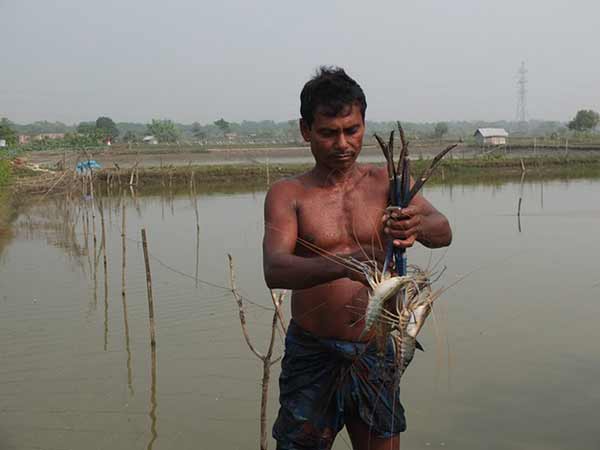
Khulna, Bangladesh (BBN)-Coastal Bangladesh is an unlikely place for a fresh water crisis.
Mighty rivers carve paths through the landscape, all the way from melting Himalayan glaciers in the north to the Bay of Bengal in the south, reports The Guardian.
Viewed from above, the countryside is an extensive patchwork of agricultural ponds, glinting in the sunlight.
But farmer Sheikh Zillur Rahman, who complains of skin disease and stomach problems, is adamant there is a problem.
“We think it’s the water,” he says, firmly. “It’s too saline.”
Rahman is from the coastal district of Khulna, the heartland of Bangladesh’s aquaculture economy.
He, like many of his neighbours, cultivates the lucrative, salt-loving shrimp.
He acknowledges that the practice of shrimp farming might be linked to his water woes – shrimp cultivation requires that his pond be kept saline, which means that salt can accumulate in the soil and leach into groundwater supplies and adjacent land.
“But there is no scope for other production here. I can’t grow vegetables, I have no livestock,” he says. He has been farming shrimp since 1989.
Shrimp cultivation became a necessity for the populations living on the external coastland when, by the 1970s, a combination of natural and manmade disasters had made the soil too salty to grow rice.
An upriver dam, for example, continues to strangle the fresh water supply.
Fierce cyclones also regularly batter the coast, inundating the land with seawater.
However, the shrimp industry is also responsible for worsening the water crisis.
It has fast became one of Bangladesh’s highest earners.
To maximise profit, large-scale commercial farmers coerced smallholders like Zillur to convert their freshwater fields into shrimp farms.
The salinity seeped ever further inland.
This has decimated the flora and fauna diversity, says Prof Dilip Datta, a lecturer in environmental science at Khulna University.
“Before, you might have found more than 10 different varieties of freshwater fish, but now you can only find two or three in some areas.”
It has also had a noticeable impact on food security.
Dr Mohammad Iqbal is a medical doctor and public health scientist who has been based in the south-east coastal district of Chakaria for almost 20 years.
He watched the devastating environmental impact of shrimp cultivation unfold first-hand.
The farmers, he says, used to be able to grow fruit and vegetables and rear livestock and poultry.
But now they completely depend on the market to feed their families.
“The shops do stock non-perishables, starchy goods like potatoes, rice and lentils,” Iqbal continues.
“But many households aren’t getting any nutrients from leafy green vegetables. At the same time, milk and eggs are almost always absent.”
Fierce cyclones regularly batter the coast in Bangladesh, inundating the land with seawater.
Children are growing up with permanent vitamin deficiencies as a result.
Data from the national rickets survey show a much higher prevalence of rickets in children from the highly saline areas compared to other field sites, Iqbal warns.
Children with rickets have weak bones and, often, skeletal deformities.
The disease is caused by vitamin D and calcium deficiency during early childhood.
Unfortunately, it can take as many as five years for the soil to regain its production potential after saltwater cultivation has stopped.
With the damage that has already been done, the farmers are caught in a catch-22; they can’t afford to do anything but farm shrimp.
This is why some non-governmental organisations have adopted a harm-reduction approach to shrimp cultivation: they promote the best agricultural practices, and encourage farmers to cultivate freshwater prawns or rice for (at least) part of the year.
By some accounts, it is a canny adaptation to environmental change.
But ultimately these are short-term solutions. It’s only a matter of time before the effects of climate change begin to compound the problem, says Saleemul Huq, the director of the International Centre for Climate Change & Development.
“Ultimately the sea level is going to rise, and the coastal land will no longer be able to support the populations there,” he continues.
“We’re never going to catch up.”
“We need a long-term migration policy, aimed at the next generation, the sons and daughters of the farmers,” he says.
“Educate them, capacitate them, make them employable.”
The warning bells are already ringing loudly in Chakaria, where Iqbal says the local populations have been entirely stripped of their natural environmental resources.
“This place used to be known as the Sundarbans of Chakaria, it was a mangrove forest,” he says.
“But now, there is almost no green left. All the mangroves are gone. Even the grass is dying.”
BBN/SK/AD